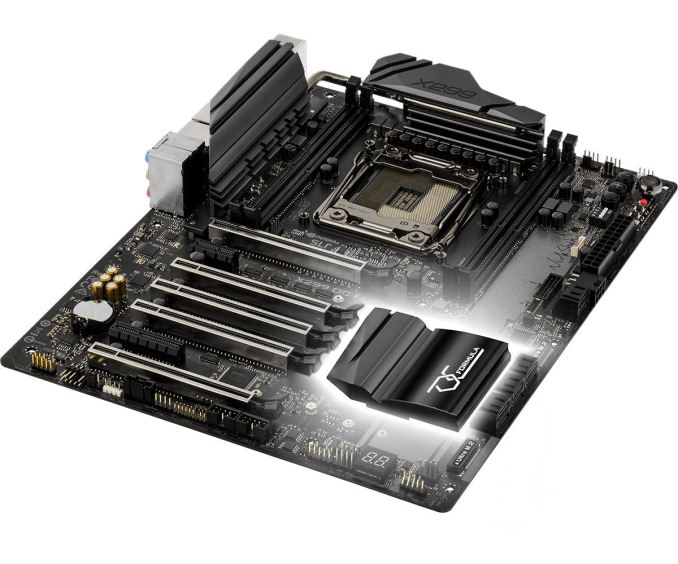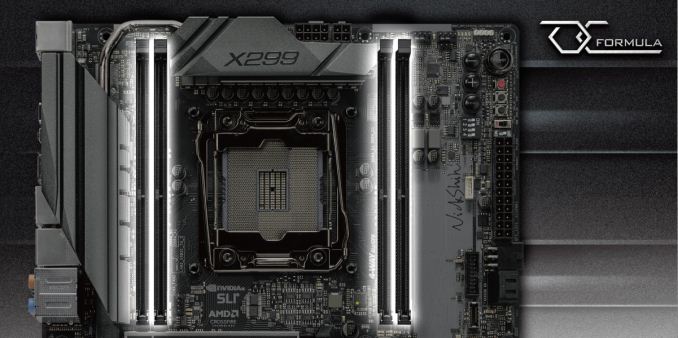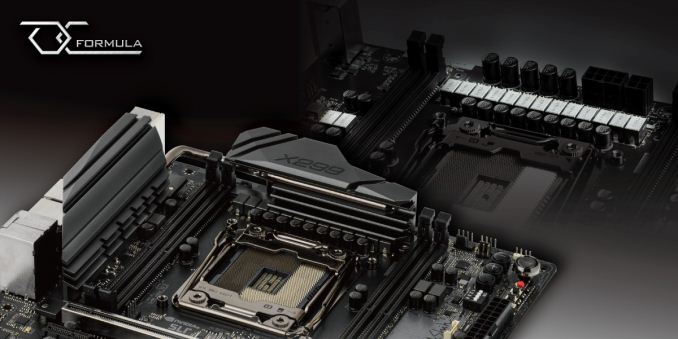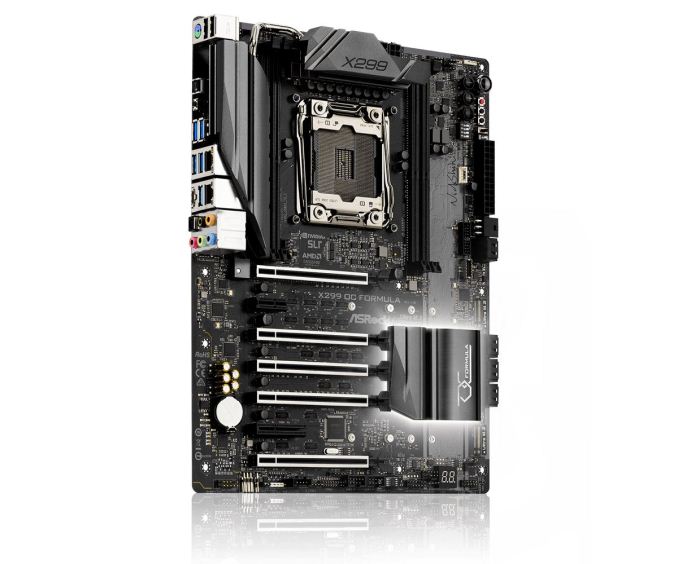ASRock Announces the X299 OC Formula Motherboard
by Joe Shields on September 11, 2017 9:00 AM EST- Posted in
- Motherboards
- ASRock
- LN2
- X299
- Skylake-X
- Kaby Lake-X
_678x452.png)
Back in May of this year, we saw our first glimpse of the X299 OC Formula, ASRock’s to-be high-end overclocking focused motherboard. In the past couple of generations, the OC Formula line was black and yellow. For X299 it has changed to black with some gray. Though it looks like most other X299 boards on the shelves, ASRock positions it as “…ideally focused on overclocking exclusively, without any other useless features, designs or gimmicks.”
One major change to previous OC Formula (OCF) boards of the past is the reduction down to one memory slot per channel. Most X299 based boards have eight slots; while the X299 OCF has four. Since the board is aimed towards overclocking, previous boards have shown one memory slot per channel has overclocking benefits, so the transition is made on the X299 version. Most users aren’t looking for the full 128GB capacity anyway, as this can put a ceiling on how fast your ram runs. ASRock states the board design aids in stability and reaching higher memory speeds, with up to DDR4 4600 (OC) officially supported out of the box, which is among the highest we have seen so far for X299. ASRock’s own in-house overclocker Nick Shih, who has helped design the OCF line for many years, has achieved DDR4-4800 with only air cooling on some high-end premium and binned memory. The X299 OC Formula will also support soon-to-be-announced DDR4-4500 XMP profile modules that will appear on the market soon.
As with past OC Formula boards, the X299 version carries over the ASRock Formula Kits (Power Kit, Connector Kit, and Cooling Kit). The 'kits' are marketing speak for features found on the board. Items such as the all DigiPower VRM design with Dr. MOS MOSFETs, a Hi-Density power 8-pin EPS connector, 15µ gold contacts, 8-layer 2oz copper PCB and the heat pipe configuration for the large VRM heatsinks, are all part of that feature package. ASRock says this heat sink configuration can supports up to 450W from the VRMs with proper airflow. The same 13 phase VRM found on the X299 Taichi and the Gaming i9 makes its way to the OC Formula as well.
Other overclocking features include an LN2 mode switch (disables CPU thermal protection, enables additional OC features), Rapid OC buttons to manually adjust the CPU ratio, the BCLK frequency, or the CPU voltages directly on the board. There are also PCIe on/off switches to disable PCIe slots, and the retry/reset/BFG button set for quick access to different types of restarts and boots. These features are found in the upper right-hand corner of the board above the ATX power. For those not wanting to manually overclock and play, the UEFI also has several of Nick's preset overclocking profiles. These range from 4 GHz all the way to extreme overclocking (liquid nitrogen, LN2) profiles. If BCLK adjustment is needed, the X299 OCF also comes with an additional external base clock generator, the Hyper BCLK Engine III. It is designed to support PCIe frequency overclocking and a wider range of BCLK frequency adjustments.
Outside of overclocking centered features, the board supports 4-Way SLI and Crossfire in its five full-length PCIe slots, has dual PCIe 3.0 x4 M.2 slots supporting both PCIe and SATA based M.2 modules, eight SATA ports, dual Intel Gigabit LAN ports, and uses the latest Realtek ALC1220 audio codec with ASRock’s Purity Sound 4 software. For those looking for RGB LEDs, the X299 OCF does have them under the PCH heatsink only.
| ASRock X299 OC Formula | |
| Warranty Period | 3 Years |
| Product Page | Link |
| Price | N/A |
| Size | ATX |
| CPU Interface | LGA2066 |
| Chipset | Intel X299 |
| Memory Slots (DDR4) | Four DDR4 Supporting 64GB Quad Channel Up to 4600 MHz (OC) |
| Network Connectivity | 1 x Intel I219V GbE 1 x Intel I211AT GbE |
| Onboard Audio | Realtek ALC1220 |
| PCIe Slots for Graphics (from CPU) | 5 x PCIe 3.0 44 Lane CPU - x16/x0/x0/x16/x8 or x8/x8/x8/x8/x8 28 Lane - x16/x0/x0/x8/x4 or x8/x8/x0/x8/x4 16 Lane - x16/x0/x0/x0/x4 or x8/x0/x0/x8/x4 |
| PCIe Slots for Other (from PCH) | 1 x PCIe 3.0 x1 1 x PCIe 3.0 x4 |
| Onboard SATA | 6 x SATA3 - Supports RAID 0/1/5/10 2 x SATA3 - Supports NCQ, AHCI, and Hot Plug via Asmedia ASM1061 |
| Onboard SATA Express | None |
| Onboard M.2 | 2 x PCIe 3.0 x4 (SATA also supported) |
| Onboard U.2 | None |
| USB 3.1 Gen 2 aka USB 3.1 (10 Gbps) |
1 x Type-A (ASMedia ASM3142) 1 x Type-C (ASMedia ASM3142) |
| USB 3.1 Gen 1 aka USB 3.0 (5 Gbps) |
4 x Rear Panel 2 x via headers (ASM1074 Hub) |
| USB 2.0 | 2 x Rear Panel 4 x via headers |
| Power Connectors | 1 x 24-pin ATX 1 x 8-pin CPU 1 x 4-pin CPU (Optional) |
| Fan Headers | 1 x CPU (4-pin) 1 x CPU Opt/Water Pump 2 x Chassis Fan 1 x Chassis Opt/Water Pump |
| IO Panel | 1 x PS/2 Mouse/Keyboard Port 1 x Optical SPDIF Out Port 2 x USB 2.0 Ports 1 x USB 3.1 Type-A Port (10 Gb/s) 1 x USB 3.1 Type-C Port (10 Gb/s) 4 x USB 3.0 Ports 2 x RJ-45 LAN Ports 1 x BIOS Flashback Switch 1 x Clear CMOS Switch HD Audio Jacks |
Pricing or details on availability were not listed at the time of publication.
Related Reading
- The Intel Skylake-X Review: Core i9 7900X, i7 7820X, and i7 7800X tested
- The Intel Kaby Lake-X i7 7740X and i5 7640X Review: The New Single-Threaded Champion, OC to 5GHz
- MSI Announces the X299 XPower Gaming AC Motherboard: Five M.2 Slots
- ASRock Announces X299 Professional Gaming i8 with 3-Way Multi-GPU, 10Gb Ethernet, & Wi-Fi
Source: ASRock







_thumb.png)
_thumb.png)








12 Comments
View All Comments
BrokenCrayons - Monday, September 11, 2017 - link
Those marketing images...they could stand to tone down the white haze around the chipset heatsink a bit.MrSpadge - Monday, September 11, 2017 - link
Why? It's sooo cool, it's freezing around the chipset!HStewart - Monday, September 11, 2017 - link
This is just marketing and I think there Marketing department did an excellent job on - I am not much of desktop person anymore - but this board and chipset sounds total awesome. It looks like it has new memory in it also.Slaveguy - Monday, September 11, 2017 - link
How did my bowel movement following a late night of eating raw meat and lifting weights end up here as a comment on Anandtech?HStewart - Monday, September 11, 2017 - link
Not sure where this @#$^ is coming from and not related to topic - any case AnandTech web site some how put this statement in wrong topic - it should have been response to the above topic.HStewart - Monday, September 11, 2017 - link
This motherboard looks like it designed very well - only one thing I wish it would have it more USB C ports than just one of them - But this maybe because it a desktop and not as important as in mobile platforms - since you don't need to provide power with it.DanNeely - Monday, September 11, 2017 - link
I'd love to see more of them too; but suspect it'll have to wait for the 300 series chipsets. Rumor has it that they'll have a half dozen 3.1g2 ports. Currently adding that speed requires a 3rd party controller and desktop mobo makers seem unwilling to offer lesser USB speeds on a C port. That strikes me as a reasonable decision; but I'd pair it with not offering the speed on A ports at all to have a pair of C's. I'm not aware of any mobo maker doing that though.HStewart - Monday, September 11, 2017 - link
To make it even better is to have thunderbolt ports - but not sure if Video portion of TB 3 would help desktop machines with dedicated Video cards - unless they found efficient way to route the video signals from card to port.DanNeely - Monday, September 11, 2017 - link
I haven't seen any options that don't amount to routing a cable from a video out on the DGPU to a video in on the mobo (or TB addon card) that can be fed into the TB output. Without cooperation from the GPU makers to either integrate a TB controller on their card or to route video out over PCIe to feed the TB3 controller I don't think it's possible. For Intels IGPs its easy since the mobo maker can route displayport out directly from the IGP into the TB controller; anything else is probably doomed to be a permakludge in desktops.stanleyipkiss - Monday, September 11, 2017 - link
Is it just me or has 10Gbit networking been absent from all X299 motherboards? What gives?